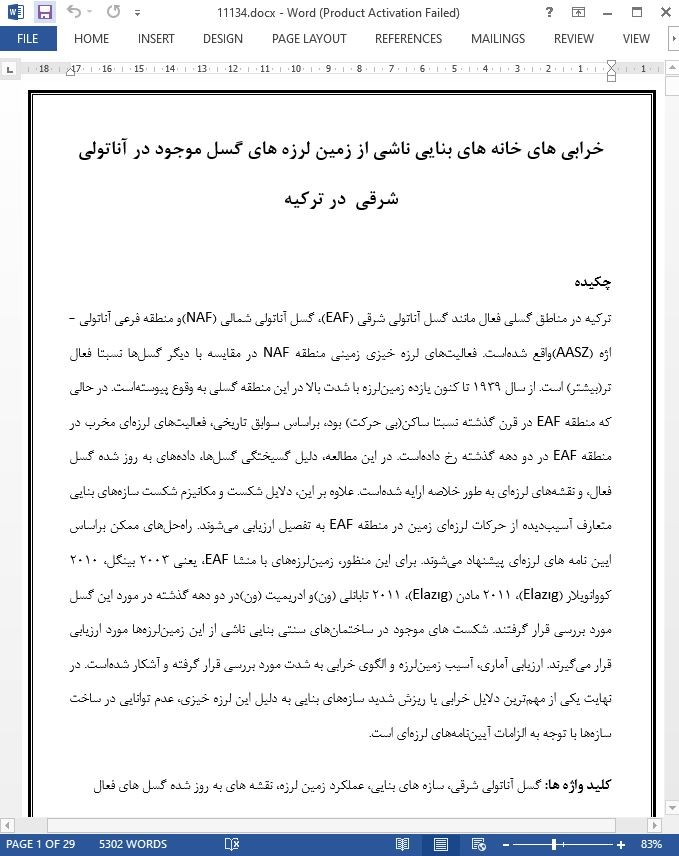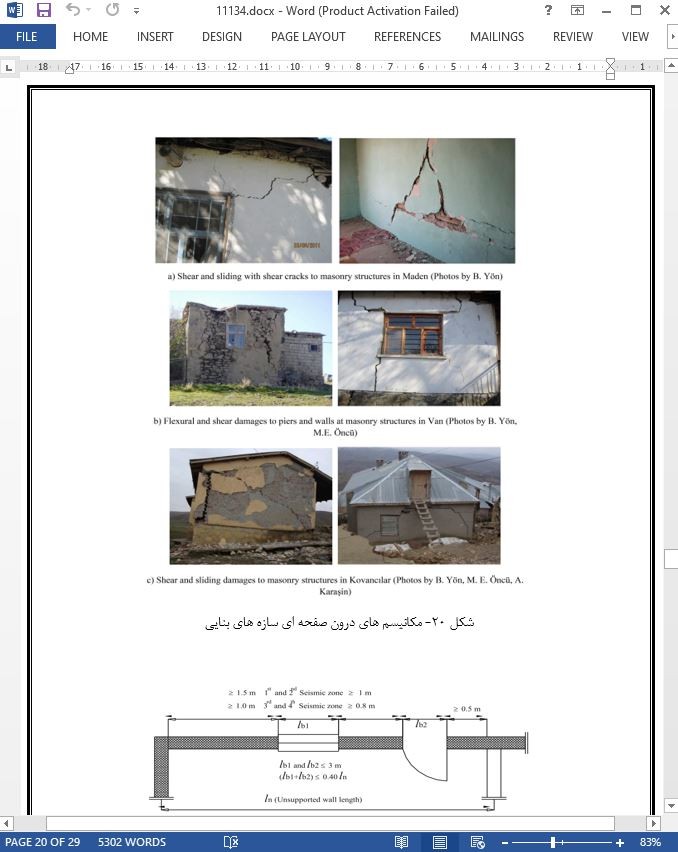
خرابی های خانه های بنایی ناشی از زمین لرزه های گسل موجود در آناتولی شرقی در ترکیه
چکیده
ترکیه در مناطق گسلی فعال مانند گسل آناتولی شرقی (EAF)، گسل آناتولی شمالی (NAF)و منطقه فرعی آناتولی - اژه (AASZ)واقع شدهاست. فعالیتهای لرزه خیزی زمینی منطقه NAF در مقایسه با دیگر گسلها نسبتا فعال تر(بیشتر) است. از سال ۱۹۳۹ تا کنون یازده زمینلرزه با شدت بالا در این منطقه گسلی به وقوع پیوستهاست. در حالی که منطقه EAF در قرن گذشته نسبتا ساکن(بی حرکت) بود، براساس سوابق تاریخی، فعالیتهای لرزهای مخرب در منطقه EAF در دو دهه گذشته رخ دادهاست. در این مطالعه، دلیل گسیختگی گسلها، دادههای به روز شده گسل فعال، و نقشههای لرزهای به طور خلاصه ارایه شدهاست. علاوه بر این، دلایل شکست و مکانیزم شکست سازههای بنایی متعارف آسیبدیده از حرکات لرزهای زمین در منطقه EAF به تفصیل ارزیابی میشوند. راهحلهای ممکن براساس ایین نامه های لرزهای پیشنهاد میشوند. برای این منظور، زمینلرزههای با منشا EAF، یعنی ۲۰۰۳ بینگل، ۲۰۱۰ کووانویلار (Elazıg)، ۲۰۱۱ مادن (Elazıg)، ۲۰۱۱ تابانلی (ون)و ادریمیت (ون)در دو دهه گذشته در مورد این گسل مورد بررسی قرار گرفتند. شکست های موجود در ساختمانهای سنتی بنایی ناشی از این زمینلرزهها مورد ارزیابی قرار میگیرند. ارزیابی آماری، آسیب زمینلرزه و الگوی خرابی به شدت مورد بررسی قرار گرفته و آشکار شدهاست. در نهایت یکی از مهمترین دلایل خرابی یا ریزش شدید سازههای بنایی به دلیل این لرزه خیزی، عدم توانایی در ساخت سازهها با توجه به الزامات آییننامههای لرزهای است.
1. مقدمه
موقعیت ترکیه در مدیترانه شرقی یکی از فعالترین مناطق زلزلهخیز جهان است. ۲۰۳ رکورد زمینلرزه با Mw ۶.۰ ثبتشده در ترکیه و در محدوده بین سالهای ۱۹۰۰ تا ۲۰۱۲ وجود دارد. تعداد ۳۲۶ گسل مجزا، پهنههای گسلی و یا سیستم ترکیبی در نقشههای به روز شده گسلهای فعال ترکیه وجود دارد. طولانیترین مناطق گسلی ردیابی شده براساس بهرهوری خود از زمینلرزه به صورت جداگانه به بخشهایی تقسیم شدند. در نهایت، ۴۸۵ بخش گسلی جداگانه که پتانسیل ایجاد حرکت لرزهای زمین را دارند در سراسر ترکیه شناسایی شدند (شکل ۱). چهار منطقه نئوزمین ساختی(neotectonic ) مختلف (شکل ۱)توسط S¸ engor در سراسر ترکیه پیشنهاد شدند: (۱)منطقه شمال آناتولی؛(۲)منطقه ی (contractional ) آناتولی شرقی؛(۳)منطقه مسطح آناتولی مرکزی وو (۴)منطقه ی وسیع آناتولی غربی.
8. نتیجهگیری و توضیحات نهایی
به عنوان نکته آخر، باید تاکید شود که EAF همچنین در مقایسه با NAF گسل فعالتری است. با توجه به نقشه لرزهای به روز شده، ۹ گسل مختلف بر روی EAF در دسترس هستند. بیشتر گسستگیها ی گشل ها توسط حرکت امتدادلغز زمینساختی(تکتونیکی) منشا گرفته میشوند. متاسفانه، فعالیت لرزهای به ندرت گزارش شدهاست که با دلیل زمین ساختی خاصی همراه نیست. علاوه بر این، فعالیتهای لرزهای با منبع زمین لغزش نیز در گذشته مشاهده شدند. این دلیل مبهم حرکت بر روی ردپای گسل ، تنوع دلیل خرابی stock سازه را تغییر می دهد. بسیاری از سازه های بنایی به دلیل انواع آسیب و دلایل فروپاشی به شدت آسیب دیده یا فرو ریختند. عمق زمین لرزه های EAF کم است و این وضعیت باعث آسیب های جدی به سازه های بنایی می شود.
Abstract
Turkey is located on active fault zones such as the East Anatolian Fault (EAF), the North Anatolian Fault (NAF) and the Anatolian-Aegean Subduction Zone (AASZ). Ground seismicity activities of the NAF zone are relatively active compared with other faults. Eleven high-intensity earthquakes have been produced on this fault zone since 1939. Whereas the EAF zone was relatively quiescent in the last century, on the basis of historical records, destructive seismic activities occurred on the EAF zone in the last two decades. In this study, the rupture reason of faults, updated active fault data, and seismic maps are presented briefly. Moreover, failure reasons and failure mechanism of conventional masonry structures damaged from seismic ground motions on the EAF zone are evaluated in detail. Possible solutions are suggested on the basis of seismic codes. For this purpose, EAF-sourced earthquakes, i.e. 2003 Bingöl, 2010 Kovancılar (Elazığ), 2011 Maden (Elazığ), 2011 Tabanlı (Van) and Edremit (Van) hit in last two decades on this fault are investigated. Failures of conventional masonry buildings triggered from these earthquakes are assessed. Statistical evaluation, damage of earthquakes and failure pattern are deeply investigated and revealed. Eventually, one of the most significant reasons of severe damage or collapse to masonry structures due to this seismicity is the inability to construct the structures according to the requirements of seismic codes.
1. Introduction
The location of Turkey in the Eastern Mediterranean is one of the most active seismic zones in the world. There are 203 events of seismic ground motion records with Mw ≥ 6.0 recorded within Turkey and the vicinity territory between 1900 and 2012 [1]. There are 326 separate faults, fault zones or combined system on the updated active fault maps of Turkey. The longest traced fault zones were divided into sections based on their productivity of earthquakes individually. Finally, 485 separate fault sections considered to have the potential to produce seismic ground motion were identified across Turkey (Fig. 1). Four different neotectonic regions (Fig. 1) were proposed by S¸ engor € [2,3] across Turkey: (1) North Anatolian region; (2) Eastern Anatolian contractional region; (3) Central Anatolian planar region; and (4) Western Anatolian extensional region.
8. Conclusions and final remarks
As a final remark, it has to be emphasized that the EAF is also active fault compared to the NAF. According to the updated seismic map, nine different faults are available on the EAF. Most of the fault ruptures are triggered by tectonic-sourced strike-slip movement. Unfortunately, rarely reported seismic activity is not associated with a certain tectonic reason. Moreover, landslide-sourced seismic activities were also observed in the past. This vague reason of movement on the fault trace changes the diversity of the failure reason of the structure stock. Many masonry structures were damaged severely or collapsed due to a variety of damage and collapse reasons. The depths of the EAF earthquakes are shallow, and this situation causes serious damages to masonry structures.
چکیده
1. مقدمه
2. مقالات مشاهدات میدانی پس از لرزه خیزی شدید و هدف مطالع
3. مرور مختصر فعالیتهای زلزلهشناسی منطقه EAF
4. نتایج لرزه خیزی شدید در EAF
5.ویژگیهای زمینلرزههای بزرگ در EAF
6. طبقهبندی ساختمانهای بنایی و راهحلهای پیشنهادی
1.6. سقفهای گلی
2.6. آسیبهای گوشه
3.6.مکانیزم شکست خارج از صفحه
4.6. مکانیزم درون صفحهای
5.6. خسارات ناشی از خاک و فنداسیون
6.6.خرابی های موضعی
7. روشهای تقویت کردن برای سازههای بنایی موجود
8. نتیجهگیری و توضیحات نهایی
ABSTRACT
1. Introduction
2. Literature of field observations after strong seismicity and aim of the study
3. Brief overview of seismological activity of EAF zone
4. Results of strong seismicity on EAF
5. Characteristics of major earthquakes on EAF
6. Classification of masonry structures and proposed solutions
6.1. Earthen roofs
6.2. Corner damages
6.3. Out-of-plane failure mechanism
6.4. In-plane mechanism
6.5. Damages arising from soil and foundation
6.6. Local damages
7. Reinforcing techniques for existing masonry structures
8. Conclusions and final remarks
- ترجمه فارسی مقاله با فرمت ورد (word) با قابلیت ویرایش، بدون آرم سایت ای ترجمه
- ترجمه فارسی مقاله با فرمت pdf، بدون آرم سایت ای ترجمه



